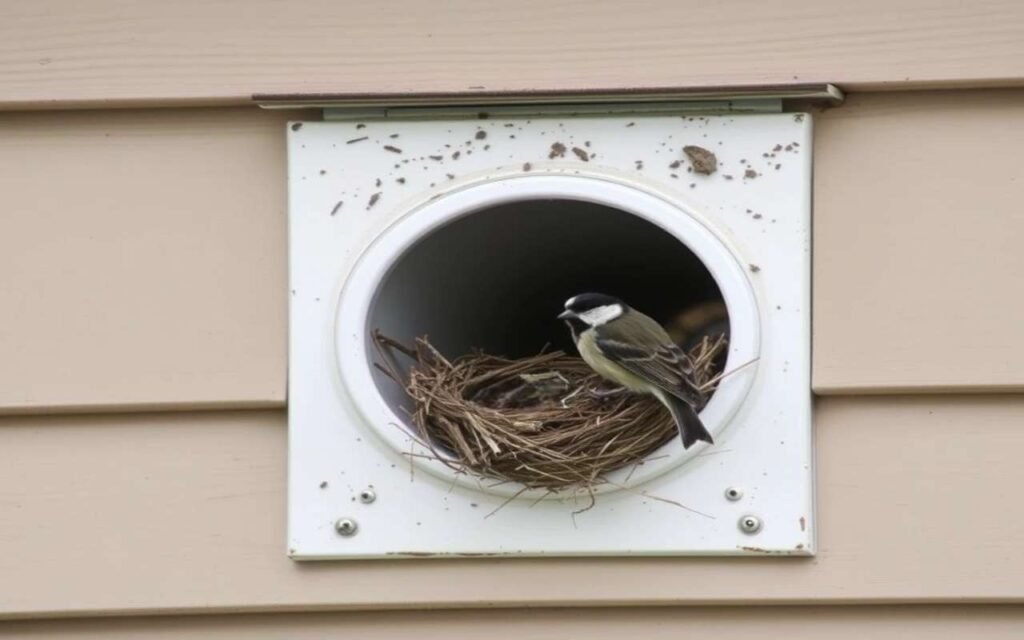Nothing ruins a peaceful Saturday morning quite like the sound of chirping coming from inside your walls 😬. I learned this the hard way when a family of house sparrows decided my dryer vent was the perfect penthouse suite for their spring nursery, which forced me to figure out how to stop birds from nesting in vents before they completely took over. The constant scratching, chirping, and the occasional whiff of “eau de bird nest” through my laundry room made me realize I needed to become an expert in avian eviction – fast.
If you’re dealing with feathered squatters in your home’s ventilation system, you’re definitely not alone. Birds see our vents as prime real estate, and honestly, can you blame them? They’re protected from predators, weatherproof, and perfectly sized for nesting. But what’s cozy for them becomes a nightmare for us homeowners.
Understanding Why Birds Love Your Vents
The Appeal of Vent Systems to Birds
Ever wonder why birds choose your specific vents over the dozens of trees in your yard? Vents offer everything a bird family could want – security, warmth, and protection from the elements. Your dryer vent, bathroom exhaust fan, and kitchen range hood create perfect nesting cavities.
Birds are opportunistic creatures. They’re constantly scouting for locations that offer maximum safety with minimal effort. Your vents check all their boxes:
• Predator protection from cats, snakes, and larger birds
• Weather resistance against rain, wind, and temperature extremes
• Consistent warmth from appliance heat output
• Perfect cavity size that matches their natural nesting preferences
Most homeowners don’t realize that certain vent designs actually attract birds. Round vents with large openings practically send out engraved invitations to every sparrow, starling, and finch in the neighborhood.
According to Critter Control, vents mimic the natural habitat of tree hollows, offering birds sheltered, safe cavity-like nesting options that are just too good to pass up.
Common Bird Species and Their Nesting Habits
Different bird species have different preferences, and understanding these quirks helps you choose the right prevention strategy. House sparrows are probably the biggest culprits – they’re aggressive, persistent, and incredibly resourceful when it comes to finding nesting spots.
According to Skedaddle Wildlife, starlings are another common problem. These birds are larger and more destructive than sparrows, often causing significant damage to vent systems. They’re also incredibly social, so if one family moves in, expect the entire extended family to follow suit.
House finches prefer slightly different conditions but can still cause major headaches. They tend to build messier nests and are more likely to abandon partially built nests, leaving you with debris-clogged vents even after they’ve moved on.
The timing matters too. Spring nesting season (March through June) sees the highest activity, but some species attempt second broods in late summer. Don’t assume you’re safe just because you made it through May without incidents.
Identifying Bird Nesting Activity
Early Warning Signs
Catching bird activity early saves you major headaches later. Once birds establish a nest and lay eggs, removal becomes significantly more complicated – both logistically and legally.
Watch for these telltale signs:
• Increased bird activity around specific vents or roof areas
• Chirping or scratching sounds from within walls or vent systems
• Visible nesting material like twigs, grass, or string near vent openings
• Reduced airflow from bathroom fans or dryer vents
• Strange odors coming from ventilation systems
I remember the exact moment I realized my dryer vent had become a bird condo. The dryer was taking forever to dry clothes, and when I went outside to check the exhaust, I found exactly zero airflow coming out. Sure enough, a thorough inspection revealed a nest so elaborate it could have been featured in Architectural Digest’s “Tiny Homes” edition 🙂
Distinguishing Between Different Types of Nests
Not all bird nests are created equal, and identifying the type helps determine your removal strategy. Sparrow nests tend to be loosely constructed with grass, paper scraps, and string. They’re relatively easy to remove once the birds have moved on.
Starling nests are more substantial affairs – these birds mean business. They use sticks, leaves, and whatever debris they can find to create fortress-like structures that can completely block ventilation systems.
Robin nests are less common in vents but occasionally show up in larger openings. These are typically cup-shaped and made from mud and grass. If you find one, consider yourself lucky – robins are excellent pest controllers and generally less problematic than cavity-nesting species.
Immediate Steps for Active Nests
Legal Considerations and Protected Species
Before you start yanking nests out of vents, know your local wildlife laws. The Migratory Bird Treaty Act protects most bird species, making it illegal to disturb active nests without proper permits According to Audubon,.
Active nests with eggs or baby birds require professional intervention in most jurisdictions. Disturbing protected species can result in hefty fines and legal complications you definitely don’t need.
Here’s what you can legally do:
• Remove nesting materials before eggs are laid
• Install deterrents during inactive seasons
• Clean up abandoned nests after birds have permanently vacated
• Contact wildlife professionals for active nest situations
The key word here is “active.” Once birds abandon a nest, you’re generally free to clean it out and install prevention measures.
Safe Nest Removal Techniques
Safety first, always. Bird nests can harbor parasites, diseases, and accumulated droppings that pose health risks. Never attempt removal without proper protective equipment.
According to Medical News Today, bird droppings can carry pathogens such as histoplasmosis and salmonella, making protective gear essential during cleanup.
Essential safety gear includes:
• Dust masks or respirators to avoid inhaling particles
• Heavy gloves to protect against sharp debris and parasites
• Eye protection from flying debris during removal
• Old clothes that you can wash or discard afterward
Turn off the affected appliance before starting any work. The last thing you want is to get blasted by hot air from a dryer vent while you’re elbow-deep in nest removal.
Work from outside whenever possible. Interior removal often pushes debris deeper into ductwork, creating bigger problems down the road. Use a flashlight to inspect thoroughly before declaring the job complete.
Prevention Methods and Deterrents
Physical Barriers and Vent Covers
The most effective bird prevention is physical exclusion – simply making it impossible for birds to access your vents in the first place. Vent covers and guards work better than any deterrent gadget you’ll find online.
Hardware cloth with 1/4-inch or smaller mesh works excellently for most applications. It allows proper airflow while keeping even the smallest birds out. Avoid chicken wire – the openings are too large for effective bird exclusion.
Commercial vent guards come in various styles:
• Hinged guards that allow cleaning access while providing protection
• Fixed screens for permanent installation on seldom-accessed vents
• Bird-specific guards designed to exclude birds while allowing proper ventilation
• Weighted flap systems that close when not in use
IMO, spending money on quality vent guards beats dealing with annual bird invasions. I installed heavy-duty guards on all my exterior vents three years ago, and I haven’t had a single nesting incident since.
Natural and Commercial Deterrents
Visual deterrents work best when combined with physical barriers. Reflective tape, predator decoys, and spinning devices can discourage birds from investigating your vents in the first place.
Predator decoys need regular repositioning to maintain effectiveness. Birds quickly learn that your plastic owl never moves, eats, or poses any real threat. Rotate decoy locations weekly and choose realistic-looking options.
Scent deterrents have mixed results. Some homeowners swear by predator urine or commercial bird repellent sprays, while others report zero effectiveness. Weather conditions quickly dilute most scent-based deterrents, making them less reliable than physical methods.
Sound deterrents can work but often annoy human neighbors more than they bother birds. Ultrasonic devices are largely ineffective – birds hear in similar frequency ranges to humans, so if you can’t hear it, neither can they.
Proper Vent Maintenance
Regular vent maintenance prevents most bird problems before they start. Clean vents with strong airflow are less attractive to nesting birds than clogged, quiet systems.
According to Freedom Wildlife Solutions, properly maintaining vents and checking for debris can significantly reduce the likelihood of birds nesting inside.
Monthly maintenance checklist:
• Clean lint from dryer vents to maintain proper airflow
• Check bathroom fan operation and clean accumulated debris
• Inspect vent covers for damage or loose fittings
• Remove any nesting materials before they become established nests
Proper vent design also matters. If you’re replacing old vent systems, choose models with integrated bird guards or smaller openings that discourage nesting attempts.
Long-Term Solutions and Modifications
Architectural Modifications
Sometimes the best solution involves modifying your home’s exterior to make it less appealing to nesting birds. This doesn’t mean major renovations – small changes often produce dramatic results.
Vent placement matters enormously. Vents positioned under eaves or in protected corners attract more birds than those in exposed locations. If you’re building new or doing major renovations, consider vent placement carefully.
Smooth surfaces around vents discourage perching and nest-building. Birds prefer textured surfaces that offer good grip for construction activities. A little strategic smoothing can go a long way.
Adding alternative nesting sites away from your home can redirect bird activity. Install nest boxes designed for your local species in areas where you don’t mind having feathered neighbors.
Seasonal Strategies
Timing your prevention efforts maximizes effectiveness. Most birds scout nesting locations in late winter and early spring, making February and March ideal months for installing deterrents.
Fall maintenance sets you up for success the following spring. Clean out any accumulated debris, repair damaged vent guards, and inspect all exterior openings for potential problems.
Winter preparation involves ensuring your deterrents can handle weather extremes. Ice, snow, and wind can damage or displace bird guards, leaving your vents vulnerable when spring arrives.
Professional vs. DIY Approaches
Most bird prevention projects work well as DIY efforts, especially if you catch problems early. Installing vent guards, cleaning accessible areas, and maintaining existing systems require basic tools and moderate handyman skills.
Professional intervention makes sense for complex installations, active nest situations, or when dealing with protected species. Wildlife control specialists understand local regulations and have specialized equipment for challenging situations.
Consider professional help when:
• Legal compliance requires permits or special handling
• Vent locations are difficult or dangerous to access
• Multiple species are involved with different behavioral patterns
• Property damage has already occurred from nesting activity
Troubleshooting Common Problems
When Deterrents Fail
Even the best prevention methods occasionally fail, usually due to determined birds or inadequate installation. Don’t get discouraged – troubleshooting failed deterrents often reveals simple solutions.
Persistent birds might indicate inadequate exclusion methods. If birds keep finding ways around your guards, you probably need smaller mesh or additional coverage. Some species are incredibly resourceful and require multiple deterrent types.
Seasonal changes can affect deterrent effectiveness. What works in spring might fail in fall when bird behavior patterns shift. Stay flexible and adjust your strategies based on observed results.
Weather damage commonly compromises bird deterrents. High winds, ice storms, and UV exposure gradually degrade most materials. Regular inspection and maintenance keep your systems effective long-term.
Dealing with Repeat Offenders
Some individual birds develop persistent nesting behavior around specific properties. These “problem birds” require targeted strategies beyond general deterrents.
Site fidelity means birds often return to previously successful nesting locations. Even after removing nests and installing guards, some birds continue attempting access for multiple seasons.
Alternative site provision sometimes helps redirect persistent birds. Installing appropriate nest boxes away from your home gives determined parents acceptable alternatives to your vent systems.
That family of sparrows I mentioned earlier? They tried three different vents on my house before finally giving up and building in my neighbor’s shed. Sometimes persistence pays off – for the birds, anyway :/
Cost-Effective Prevention Strategies
Budget-Friendly DIY Solutions
Effective bird prevention doesn’t require breaking the bank. Simple hardware store materials often work better than expensive specialty products.
Budget-friendly options include:
• Hardware cloth cut to fit standard vent openings
• Aluminum flashing formed into custom covers
• Mesh screening attached with weatherproof fasteners
• Reflective tape strategically placed around problem areas
Creative repurposing can provide effective solutions. Old window screens, discarded gutters, and leftover construction materials often work perfectly for bird exclusion projects.
Group purchases with neighbors reduce per-unit costs for specialty items. If multiple houses on your street have bird problems, coordinate your prevention efforts and split material costs.
Long-Term Investment Considerations
Quality prevention pays for itself over time through reduced maintenance, avoided property damage, and eliminated professional service calls. Cheap solutions often create more problems than they solve.
Material lifespan varies dramatically based on quality and installation methods. Stainless steel guards last decades, while plastic alternatives might need replacement every few seasons.
Installation quality matters more than material costs in most cases. Properly installed budget materials outperform poorly installed premium products every time.
Consider the total cost of ownership when choosing prevention methods. Initial savings on cheap materials disappear quickly if you’re replacing them annually or dealing with ongoing bird problems.
Birds are incredibly persistent creatures, and they’ve been perfecting their nesting strategies for millions of years longer than we’ve been building houses. The good news? With proper prevention and a little patience, you can definitely win this battle.
The key is consistency – half-measures and temporary fixes just create ongoing frustration. Invest in proper solutions from the start, maintain them regularly, and you’ll enjoy bird-free vents for years to come. Trust me, your Saturday mornings will thank you when they’re filled with actual peace and quiet instead of unwanted chirping concerts from inside your walls.



